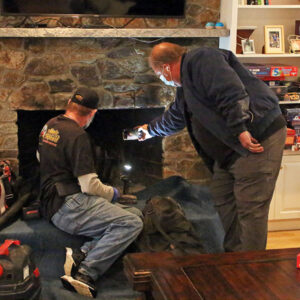Levels of Chimney Inspection
Chimney inspection starts with a visual examination. But it’s not always easy to see all the damage because of a crowded look or the presence of creosote.
A Level 2 inspection includes additional areas surveyed, including those that are only accessed by using a scope. It also includes the parts of the chimney’s interior and exterior that can be reached from a crawl space or attic.
Level 1 inspections are very common and are typically done when the fireplace system is being swept or cleaned. During this level of inspection, the chimney sweep will look around the exterior of the fireplace to ensure there are no major issues with the structure of the chimney or its surrounding areas. The chimney will also be examined for creosote accumulation and any cracking or other possible hazards.
A chimney technician will perform a Level 2 inspection with the use of special equipment to see more than what is visible with just a visual inspection. These types of equipment include a camera that can be extended deep inside the chimney to scan for any areas that may not be easily seen by the naked eye. This type of inspection also includes a video scan of the fireplace flue to see any areas that may be difficult to get to with a regular chimney sweep’s tool set.
The National Fire Protection Association (NFPA) outlines three “levels” of chimney inspection in Code 211. A level 1 inspection is the minimum required for a regularly used chimney that has not had any changes in the system’s appliances or venting. The NFPA recommends this inspection be done on an annual basis to ensure the system is working as it should.
If your chimney has recently undergone a change to the system, such as changing the fuel type or adding a new chimney or fireplace insert, then you will need a Level 2 inspection. These types of changes could possibly lead to a change in the shape or material of the flue or even the addition of an appliance with a different input rating or efficiency.
Lastly, a Level 3 inspection is required any time a Level 1 or Level 2 inspection discovers a serious problem that requires further examination. This could include a chimney fire, a natural disaster, or structural damage to the fireplace and chimney system. A certified engineer or nondestructive testing specialist is usually needed to complete this level of inspection.
While the inspection process can be complex, truck drivers and fleet owners can protect themselves from DOT penalties by doing a little prep work. To prepare for a DOT inspection, make sure you remove any picture frames, knick-knacks, or other items from the fireplace area that could get in the way of the technician’s examination and cleaning. Also, clean out the fireplace to remove logs, ashes, and soot. This will help speed up the inspection process and give you a clearer view of your fireplace’s condition.
When you choose a level 2 chimney inspection, your technician will examine every component that is accessible. This includes the firebox, flue liner, and the chimney structure itself. They’ll look for cracks, water damage, and other problems that could put your home at risk. Your chimney technician will also assess the crown, a downward-sloping concrete or stone overhang at the top of your chimney that diverts rainwater away from the masonry structure to prevent erosion. If the crown is cracked or deteriorating, it can allow rain to slip inside the chimney and degrade the flue liner over time.
When a fireplace or wood-burning stove is used, by-products such as smoke, vapor, and unburned wood move through the chimney and condense. This forms a dark brown to black coating called creosote. If the chimney isn’t properly cleaned or maintained, the creosote can build up to a point where it’s too thick to vent gases. The resulting blockage is flammable and can cause chimney fires.
As a result, a chimney fire can be catastrophic for a family. Not only can it destroy the chimney structure, but it can also threaten the safety and health of the people in the home. Moreover, it can cause property loss and even financial ruin for the homeowners. Luckily, regular chimney sweeping can reduce the risk of a chimney fire and keep it from getting worse.
A level 2 chimney inspection is important for anyone who owns a fireplace or wood-burning stove. It’s especially important if you have made changes to your fireplace or venting system. This includes changing the fuel type, modifying your flue’s material or shape, or installing a new insert. During a level 2 chimney inspection, your chimney sweep will determine whether the changes have affected the drafting or safety of the system.
It’s also a good idea to get a Level 2 chimney inspection before buying or selling a house. That way, you can ensure the chimney is safe and ready for use by the new owners. Moreover, you can prove the chimney was inspected recently to avoid any potential disputes over when it was last swept.
As the name suggests, a Level 3 inspection is a deeper look at specific areas of concern. It may involve some destructive action, and the cost can be high. However, your technician will work with you to come up with a plan that meets the needs of your company and the situation.
Level 3 inspections are most common when the previous two levels of inspection uncover potential dangers that require further investigation. In these situations, it’s important that your technician has extensive experience in the field and a background in engineering or non-destructive testing to conduct a thorough assessment of the area in question.
This level of inspection also requires the use of more invasive methods, including visual and non-visual tests. These tests can reveal the presence of hidden deterioration that can’t be detected with normal methods. These results can help identify and isolate special causes, which can then be countered by implementing preventative measures.
A Level 3 inspection is a roadside safety check that includes an examination of the driver’s license, medical examiner’s certificate, skill performance evaluation, alcohol and drug tests, hours of service, seat belt, vehicle inspection report(s), brake systems, cargo securement, coupling devices, exhaust systems, frames, fuel systems, headlamps, tail lamps, stop lamps, turn signals, and lamps or flags on projecting loads, steering mechanisms, tires, van and open-top trailer bodies, wheels, rims, and hubs, and bus, motorcoach, and passenger van body parts, electrical cables, and systems.
While the General II inspection level is usually the default choice, you should choose a higher inspection level if your supplier has given you sticky quality issues. It’s also worth considering if you’re working with a new supplier or have an inexperienced inspector on staff.
The level of inspection you choose should reflect the confidence you have in your inspection results. Generally speaking, the higher the inspection level, the better your quality control. However, keep in mind that this can increase your costs, so you’ll need to weigh the pros and cons carefully before making any decisions.
The level 4 inspection is a special type of visual inspection that is used to check for specific defects. It is best used when you have a large number of defects but want to focus on a specific set of defects. This can be done using a Pareto analysis to identify the most common defects. Then, a root cause analysis (RCA) can be performed to determine the cause of the defect, and countermeasures can be drafted and implemented.
Keeping your fleet in compliance with inspection protocols is essential to avoid fines and negative publicity. Having quarterly training sessions can help drivers feel supported and prepared to meet the demands of DOT protocol. This will also make it easier for them to stay compliant when inspections are scheduled throughout the year.




